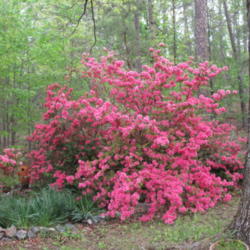
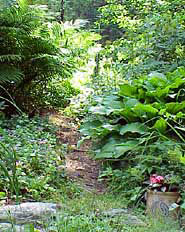
If you've inherited a shady new home or watched your trees gradually obstruct the sun from your yard, you're facing the challenge of gardening in the shade. The good news is that although you can't grow full-size tomatoes or sunflowers in the shade, you can grow hundreds of different perennials, grasses, ground covers, and annuals - many with unique foliage colors and textures.
There's no doubt shade gardening can be challenging. Soil can stay too damp, encouraging rot diseases and slugs. Plants growing under trees and shrubs must compete with the larger plants' root systems for water and fertilizer . Plus, the selection of colorful, shade-tolerant flowers is more limited than the choices for full sun.
There are also many advantages to gardening in shade. Plants grow slower due to lower light levels and cooler temperatures. Flowers often last longer, and their colors don't fade as much as they might in full sun. Foliage colors and textures become more noticeable. Shady areas are cool to work in and create great wildlife habitats for birds, toads, and other beneficial creatures.
Before you cultivate under your maple tree or against the north side of a wall, decide the type of shade you have to determine what to grow.

It's not just the amount of sun your garden receives that determines what can be grown, but also the intensity of the sun. Morning sun is generally gentler than afternoon sun. The sun in northern areas is less intense than in southern areas, which allows northern gardeners to grow shade-loving plants in somewhat sunnier locations.
Shade can vary by season as well. As the sun moves across the sky from spring to fall, an area that receives full sun early in the season may be partly shaded by midsummer, only to become sunny again in fall as the sun's angle changes. Areas under deciduous trees receive full sun in early spring when branches are bare, followed by shade in summer after leaves emerge. This makes them perfect for spring-flowering bulbs that go dormant in summer.
Listed below are the four basic types of shade and the plants that will grow best in each of those light levels.
Deep shade. Large evergreen or deciduous trees with low branches, such as Norway spruce, American hemlock, and eucalyptus, cast deep shade. The soil under these trees is often filled with mature tree roots. Only a few plants, such as moss, will grow well under these challenging conditions.
Medium shade. Medium shade is found under mature deciduous trees, such as maples, whose lowest branches are 20 feet or more off the ground. It's also the shade you'll find against the north side of a wall or hedge. These areas tend to be shaded most of the day with perhaps some dappled light in the early morning or late evening. Plants such as hostas and ferns grow well in medium shade.
Dappled shade. Small, deciduous trees, such as flowering plum; or larger deciduous trees with high, lacy canopies, such as honey locust, cast dappled shade. Although little direct sun reaches the plants underneath them, bright light filters through the canopy all day. Many plants with colorful flowers and/or foliage, such as azalea, mountain laurel, bleeding heart, ligularia, pulmonaria, and lamium, grow well in dappled shade.
Part shade. Areas in part shade receive 3 to 4 hours of direct sun a day, but not necessarily all at once. Most shade-loving plants, such as astilbe, coleus, impatiens, heuchera, and tiarella, grow well under these conditions.
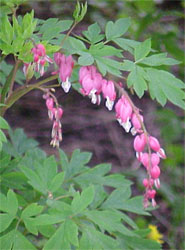
Here are eight, widely adapted, shade-loving perennial flower selections (many with interesting foliage) that are hardy in USDA zones 4 to 9.
Astilbe. False spireas range in height from 6 inches to 4 feet tall, depending on the variety. Feathery pink, red, white, or lilac flower plumes emerge in midsummer. Some varieties, such as 'Sprite', have bronze-colored foliage.
Dicentra. Bleeding heart is a 1- to 2-foot-tall, feathery-leafed perennial that blooms in spring and early summer. Varieties have pink, red, or white, heart-shaped flowers. Some varieties, such as 'Golden Heart', have light yellow foliage.
Ferns. There are hundreds of species and varieties of ferns that thrive in the cool, damp conditions often found in the shade. Many are evergreen in warmer climates. The selections range from the 6-inch-tall dragon's tail fern to the 3- to 5-foot-tall ostrich fern. Some ferns have unique foliage, such as the Japanese painted fern (Athyrium niponicum 'Pictum'), with its silvery fronds with red highlights.
Heuchera. Coralbells produce 1- to 3-foot-tall, feathery spikes of white, pink, red, or purple flowers in summer. The evergreen foliage can be light or dark green, silver, gold, red, or purple, depending on the variety. 'Palace Purple' is a popular, white-flowered, purple-leafed variety.
Hosta. The quintessential shade plant, hosta varieties range in size from the diminutive 6-inch-tall 'Cat Eyes' to the dominant, 3-foot-tall 'Royal Standard'. Foliage colors include bright green, blue, yellow, and variegated forms of these colors. All varieties produce white or lilac flowers on stalks in midsummer. The flowers of some varieties, such as 'Fragrant Bouquet', have a pleasant scent.
Ligularia. Ligularia are 3- to 6-foot-tall plants with 1- to 2-foot-tall, yellow flower heads in mid to late summer. Ligularia flowers best in moist areas that receive part sun. The variety 'Dark Beauty' features chocolate-colored, kidney-shaped leaves.
Pulmonaria. Lungwort or Bethlehem sage grows best in cool, moist soil, producing pink, blue, or white flowers on 6- to 12-inch-tall plants. The sword-like foliage can have white variegation, such as on the variety 'Moonshine'.
Tiarella. Foamflower produces 12- to 16-inch-tall white or pink flower spikes in early spring. Some varieties, such as 'Iron Butterfly', have black or red blotches or stripes on the leaves.
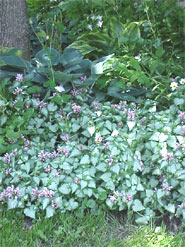
Many ground covers make excellent shade garden plants, including vinca, lamium, ajuga, and sweet woodruff (Gallium). Vinca features blue, purple, or white flowers; the variety 'Illumination' has gold and green leaves. Lamium (deadnettle) has variegated silver and green foliage and produces pink or white flowers. Ajuga varieties such as 'Metallica Crispa' feature bronze-colored leaves and purple flower spikes. Sweet woodruff produces fragrant, white flowers. These ground covers are hardy in zones 4 to 9.
While many ornamental grasses grow well in part shade, here are two unusual grasses to try. Black Mondo grass or monkey grass (Ophiopogon planiscapus 'Nigrescens') is an 8- to 10-inch-tall, clumping evergreen that features shiny, almost black, leaf blades. Japanese forest grass (Hakonechola macra) features 12-inch-tall, cascading, green, yellow, or cream-colored striped leaves. Mondo grass and Japanese forest grass are hardy in zones 6 to 9.
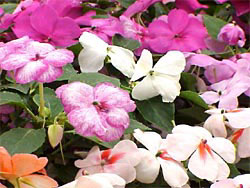
Annual flowers are the perfect match for a shade garden that needs instant color. They often can be grown in containers, especially where the soil is poor. Impatiens, begonias, browallia, primrose, and torenia will bloom in part shade. Some annuals that feature colorful foliage to brighten the shade are coleus, perilla, and polka dot plant (Fittonia).
Accessorizing the GardenGardening in shade involves more than plants. Shady places provide great opportunities to decorate your garden with art and furniture. Consider placing a bench under a shade tree so you can sit and enjoy the view of your garden. You can also strategically place a sculpture or hanging wind chime in a shady area to draw people into the garden. These items can make the garden seem more alive and provide a pleasurable spot to rest.
 Charlie Nardozzi is an award winning, nationally recognized garden writer, speaker, radio, and television personality. He has worked for more than 30 years bringing expert gardening information to home gardeners through radio, television, talks, tours, on-line, and the printed page. Charlie delights in making gardening information simple, easy, fun and accessible to everyone. He's the author of 6 books, has three radio shows in New England and a TV show. He leads Garden Tours around the world and consults with organizations and companies about gardening programs. See more about him at Gardening With Charlie.
Charlie Nardozzi is an award winning, nationally recognized garden writer, speaker, radio, and television personality. He has worked for more than 30 years bringing expert gardening information to home gardeners through radio, television, talks, tours, on-line, and the printed page. Charlie delights in making gardening information simple, easy, fun and accessible to everyone. He's the author of 6 books, has three radio shows in New England and a TV show. He leads Garden Tours around the world and consults with organizations and companies about gardening programs. See more about him at Gardening With Charlie.